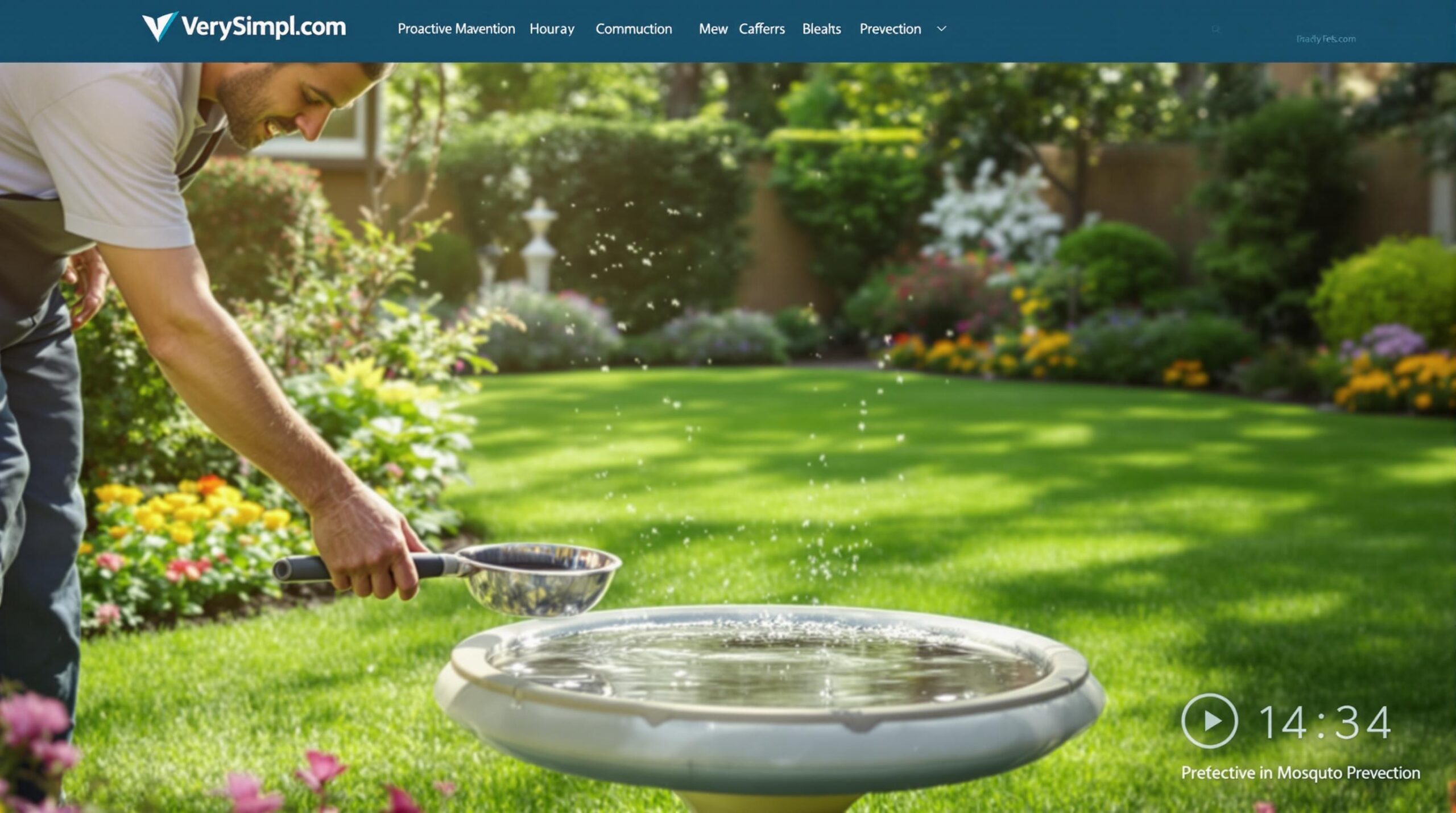Mosquitoes are more than just annoying – they can spread serious diseases like malaria, dengue, and Zika. To keep your yard mosquito-free, focus on these key steps:
- Eliminate standing water: Mosquitoes need just an inch of water to breed. Regularly empty bird baths, plant saucers, and outdoor containers.
- Inspect common breeding spots: Check clogged gutters, puddles, and poorly drained areas after rain.
- Use preventive measures: Add larvicides to water features, grow mosquito-repelling plants like citronella and lavender, and repair leaks or drainage issues.
How To Stop Mosquitos From Breeding in Your Back Yard
Understanding Mosquito Breeding
If you want to keep mosquitoes out of your yard, it’s crucial to know how they live and where they breed. This knowledge lets you take targeted steps to stop them.
1. Mosquito Lifecycle
Mosquitoes go through four stages, and the first three depend on standing water. In the right conditions, they can grow from egg to adult in just 5 days [5]. Their development is heavily influenced by temperature and humidity [4].
| Stage | Duration | Environment Needed |
|---|---|---|
| Egg | 48 hours | Standing water |
| Larva | 2-3 days | Standing water |
| Pupa | 1-2 days | Standing water |
| Adult | 2-4 weeks | Air |
2. Common Breeding Spots in Yards
Mosquitoes often breed in places you might not notice. Getting rid of even small amounts of standing water can make a big difference.
Key breeding spots include:
- Water-collecting structures:
- Clogged gutters filled with leaves
- Bird baths and decorative water features
- Tree holes and natural cavities
- Garden and lawn areas:
- Flowerpots and plant saucers
- Puddles caused by overwatering
- Poorly drained parts of your lawn
- Outdoor items:
- Containers like toys, buckets, and tire swings
- Equipment that collects rainwater
- Forgotten objects left in yard corners
Inspect these areas regularly, especially after rain or watering. Spotting these breeding grounds early is key to keeping mosquitoes at bay.
Removing Standing Water to Prevent Breeding
Mosquitoes thrive in standing water, making it crucial to eliminate these spots to keep their populations in check. By addressing water sources early, you can significantly reduce the risk of infestations.
1. Check and Clean Gutters
Gutters can easily become mosquito havens if clogged with debris. Regularly clean them, especially after heavy rain or during the fall when leaves accumulate. Installing gutter guards and ensuring downspouts drain properly can go a long way. According to the Centers for Disease Control and Prevention (CDC), maintaining gutters is an important step in controlling mosquitoes [4].
2. Manage Yard Items
Everyday items in your yard can turn into mosquito breeding grounds. Here’s how to handle them:
| Item Type | Action to Take | How Often? |
|---|---|---|
| Bird Baths | Replace water | Weekly |
| Plant Saucers | Empty or remove | After each rain |
| Tire Swings | Drill drainage holes | One-time fix |
| Outdoor Containers | Store upside down | After each use |
| Pool Covers | Remove pooled water | Within 24 hours of rain |
3. Repair Leaks and Drainage
Water pooling from leaks or poor drainage can create long-term problems. Address these issues quickly:
- Fix any outdoor leaks.
- Install French drains to redirect water.
- Regrade areas of your yard where water collects.
- Repair irrigation systems to avoid unnecessary pooling.
For more stubborn drainage problems, consider planting a rain garden with plants that naturally absorb excess water [6][7].
Pro tip: Pay extra attention to spots where water lingers for more than 48 hours after rainfall. These areas are prime mosquito breeding grounds.
sbb-itb-5a38398
Additional Mosquito Control Methods
Once you’ve tackled standing water, these extra steps can help keep mosquitoes at bay in your yard.
1. Treat Water Features with Larvicides
For water features that can’t be emptied, larvicides are a practical solution. Products like Mosquito Dunks or Bti granules (a bacterium that targets mosquito larvae) work well in bird baths, ponds, and fountains. Apply them every 7-14 days [4]. If you have a natural pond, adding mosquito-eating fish like goldfish can provide a biological way to manage larvae.
2. Add Mosquito-Repelling Plants
Certain plants can act as natural mosquito deterrents while sprucing up your outdoor space. Popular choices include:
- Citronella grass
- Lavender
- Marigolds
- Basil
These plants not only repel mosquitoes but also add visual appeal to your yard.
3. Use Mosquito Control Devices
Devices like fans and misting systems can physically reduce mosquito presence. Outdoor ceiling fans, for example, disrupt mosquito flight, making it harder for them to bite. Misting systems can spread natural repellents like cedar oil to cover larger areas.
When picking a control device, consider:
- The size of your yard
- How severe the mosquito problem is
- Your budget
- Whether it’s safe for kids and pets
Natural options like cedar oil are especially helpful for households with sensitive needs.
If the problem persists, professional pest control services can provide extra help for more serious infestations.
When to Use Professional Pest Control
If mosquitoes keep buzzing around despite your best efforts, it might be time to call in professional pest control. These services can tackle more stubborn or complicated infestations and work alongside your DIY methods.
1. Why Choose Professional Services?
Professionals bring specialized tools and expertise to the table, offering solutions that go beyond what you can achieve on your own. Here’s what they provide:
- Advanced Detection: They use tools to locate mosquito breeding spots, even in tricky areas like underground drains or hidden corners.
- Tailored Solutions: Treatments are customized to address the specific needs of your yard.
- Stronger Formulas: They apply products that last longer and are more effective than over-the-counter options.
- Safe Practices: Methods are designed to be safe for your family and the environment.
2. Simpl: Mosquito and Pool Services

If you’re in San Antonio or nearby areas, Simpl offers a quarterly mosquito control program that combines yard and pool care for maximum effectiveness:
| Service Component | What It Includes |
|---|---|
| Yard Inspection | Identifies mosquito breeding grounds |
| Treatment | Applies long-lasting mosquito control |
| Pool Maintenance | Keeps pools clean to prevent breeding |
| Follow-Up Care | Regular checks and adjustments |
This integrated approach is especially helpful for homes with pools, as it combines mosquito prevention with proper pool upkeep.
You might want to consider professional pest control if:
- DIY methods haven’t solved the problem.
- Your property has unique features that make it harder to treat.
- You live in an area with high mosquito activity.
- You’re looking for reliable protection against mosquito-borne illnesses.
Even with professional services, keeping up with regular maintenance is key to staying mosquito-free.
Maintaining a Mosquito-Free Yard
Regular Inspections
Keeping mosquitoes at bay starts with consistent weekly inspections. Focus on areas where water might collect, such as:
- Water Features: Look at bird baths, fountains, and ponds.
- Container Items: Empty items like flowerpots, buckets, and outdoor toys.
- Drainage Points: Clear out gutters, downspouts, and drains.
- Landscape Areas: Check for low spots in the yard or tree holes.
Standing water is a breeding ground for mosquitoes, and eliminating it can cut their population by up to 90% [2]. After heavy rain, inspect again to catch any new water buildup.
Regular checks are essential, but adjusting your approach based on the time of year can make your efforts even more effective.
Seasonal Adjustments
Mosquito prevention isn’t a one-size-fits-all task. Adjust your strategy as the seasons change. For example, keep fountains and waterfalls running during warmer months to avoid stagnant water [3].
Here’s how to tackle each season:
- Spring: Clear out winter debris, fix torn screens, and begin weekly water checks.
- Summer: Inspect more often, prevent water pooling from irrigation, and trim overgrown plants.
- Fall: Rake up fallen leaves quickly, clean drainage systems, and prepare water features for the colder months.
Conclusion: Keeping Your Yard Mosquito-Free
Keeping mosquitoes at bay takes effort throughout the year. A mix of methods works best – get rid of standing water, treat water features with larvicides, and grow plants that naturally repel mosquitoes. For ponds or other permanent water features, mosquito-eating fish can be a helpful, natural solution [1].
Make mosquito prevention part of your regular yard care, especially after it rains. Since mosquitoes can easily migrate between properties, teaming up with neighbors can make a big difference. Share tips, and consider organizing neighborhood clean-ups to tackle common breeding spots [2]. With consistent action, you can create an outdoor space that’s safer and more enjoyable all year long.






